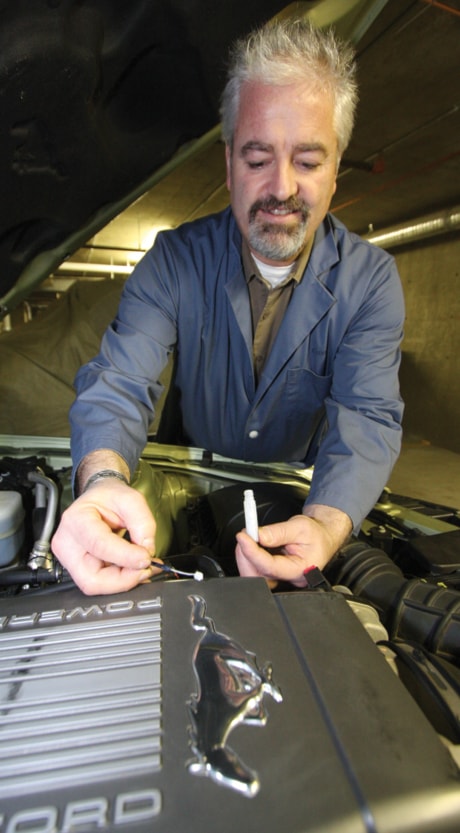Louis Bouchard opens a small container and dabs some of its contents onto a business card.
The translucent liquid has the appearance and consistency of glue, but under a magnifying glass tiny specs can be seen suspended in it. And etched on those specs is a 12-character code that can be linked to a name in an online database.
Welcome to the world of microdot identification, a technique for safeguarding vehicles and other personal property from theft. Helping push the technology forward is Red Deer company Certified Secure Identification Corp. — or CSI.
Bouchard, who is president of CSI, said the business is one of only three microdot manufacturers in the world. In production since last year, CSI has already sold its trademarked I-DOT identifiers to customers in about a half-dozen countries.
One from the Netherlands recently ordered 1,000 I-DOT applicator kits, with bigger contracts pending.
“Some of the deals that we’re working on right now are upwards of 30,000 applicators a month,” said Bouchard.
“We’re doing a lot overseas because there’s more knowledge about the microdot system overseas than there is in Canada and the U.S.”
A standard I-DOT kit for home use contains up to 1,000 microdots, or enough to mark 50 to 80 items. But customized kits could have as many as 10,000 microdots.
Each microdot in an I-DOT kit contains the same code, which can be registered in the user’s name on a secure website.
Although the adhesive solution that bonds the microdots to the asset is virtually invisible, it glows purple when exposed to an ultraviolet black light. That allows law enforcement officials to locate and read the microdots, said Bouchard.
By applying microdots in a variety of places — dozens in the case of a vehicle — the likelihood of thieves finding and removing all of the identifying markers is remote. CSI even provides “I-DOT protected” decals for marked items.
“We want the thieves to know this thing is microdotted,” said Bouchard.
CSI offers a theft warranty of up to $4,000 on vehicles with I-DOT microdots placed by a certified applicator. Similar warranties are being developed for recreational and power sports vehicles.
Microdot technology has been around since the Second World War, but it’s only been used to trace assets for about a decade, said Bouchard.
His brother Denis, who lives in Australia, raised the possibility of starting a microdot business a few years ago. With the proliferation of vehicle thefts, Bouchard saw the potential.
CSI resulted in 2007, with the private company acquiring a microdot manufacturing unit from the United Kingdom soon after.
The production process is “fairly complex,” said Bouchard, explaining that quality control is critical to ensure the integrity of the system — important when law enforcement officials rely upon it.
“Nobody knows where the plant is, and that’s the way it’s got to stay,” he added.
Much of CSI’s early efforts have focused on raising awareness about the I-DOT system with government officials, insurance companies, law enforcement agencies, vehicle dealer associations and others.
Canadian Powersports Group Inc., which represents watercraft, motorcycle, all-terrain vehicle and snowmobile dealers across the country, has negotiated a special rate on I-DOT kits for its members.
Andrew Gowers, the organization’s director of operations, said the I-DOT system deters thefts and “greatly increases” the chance of identifying stolen property and returning it to its owner. He believes it could undermine the market for stolen units and parts, and help decrease insurance rates on power sports vehicles.
Cal Colbo, owner of Champion Cycle Power Sports in Olds, is another advocate. He’s put 1,000 I-Dot microdots on his own Suzuki 1200 Bandit motorcycle.
“With power sports, especially ATVs, thefts are huge,” he observed. “And they rarely, if ever, get recovered.”
Thieves will strip down a stolen unit and destroy its serial numbers, said Colbo. With microdots, this process becomes much trickier — especially when the component parts are marked.
“As a thief . . . I’d walk away from anything that has ‘Microdot-protected’ written on it.”
Colbo thinks power sports dealers should start microdotting the products they sell. It would give them another source of revenue and provide customers with theft protection and perhaps even savings on insurance.
Bouchard said CSI is working with corporate partners on more sophisticated security measures for its I-DOT system. These include the possibility of discouraging counterfeiting of products like brand-name clothing by embedding them with DNA coding from someone like the manufacturing company’s founder.
Additional information about Certified Secure Identification Corp. can be found online at www.csi-dots.com.
hrichards@www.reddeeradvocate.com
